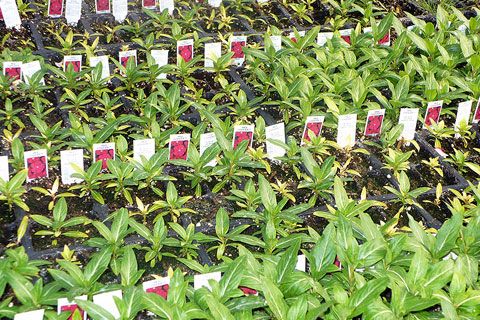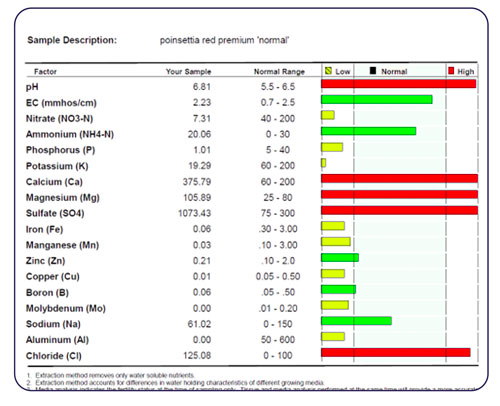7/1/2023
The Benefits of Horticulture Testing
Joann Peery

One of the most valuable tools in the professional grower’s toolbox is independent laboratory testing. This testing should be a part of every grower’s IPM program, providing invaluable information on the quality of their water, as well as the nutrient levels in their crop’s tissue and growing media.
The reasons for laboratory testing include detecting nutritional issues before symptoms appear, monitoring cultural trends that can lead to plant growth issues, identifying sources of problems and determining if previous corrective actions are working.
A secondary purpose for laboratory testing is to evaluate the performance of various products within the greenhouse. When a grower sets up a new product trial or demonstration in their greenhouse to compare the performance between different growing media formulations, laboratory testing can provide information on the nuances between the different growing media that may not be visibly apparent when simply viewing the crop.
Growing media testing
Media testing provides the pH of the growing medium and a snapshot of the nutrients currently available to the crop. The ideal pH for most crops is between 5.5 to 6.2. If the pH moves outside this range, some nutrients may become unavailable, while others may become available in toxic levels that could result in poor growth, or ultimately, plant death.
The results from growing media testing will provide the EC (electrical conductivity) of the growing medium, which is a reading of the total dissolved salts in the media. If the EC is too high, it can be an indicator of a buildup of nutrients caused by inadequate leaching during irrigation, excessive soluble salts in the irrigation water, excessive application of water-soluble fertilizer or rapid release of controlled-release fertilizers, if used.
Tissue testing
While growing medium testing provides a snapshot of the nutrients available at the time of sampling, tissue testing provides a historical view of nutrient availability from when those leaves were first developing (one to three weeks prior to sampling). In combination, tissue and media testing can provide information as to trends or if a condition is deteriorating or if corrective measures are effective. In the case of a product trial/demonstration, the combined tests can show the positive or negative performance of the different growing media formulations within the demonstration, which may not yet be visible.

Water & nutrient testing
The primary goal of testing water quality is to determine the level of alkalinity, EC and undesirable elements in the water. Alkalinity is a measurement of the dissolved limestone in the water that, in excessive levels, will cause the growing media pH to rise over time, which can result in nutrient availability issues. EC is a measurement of the total dissolved soluble salts in the water, which in excessive levels can build up in the plant tissue, resulting in root and leaf tip burn.
Pictured: This vinca crop has normal, healthy plants intermixed with stunted, chlorotic plants. To find out the cause of the problem, test media and tissue from the normal vinca and the stunted, chlorotic vinca. Comparing the test results can provide critical information in identifying a nutrition problem.
Evaluating the greenhouse water source will also alert the grower to any undesirable elements such as chloride and sodium in the water that could result in toxic levels and can compete with nutritive elements from fertilizer. Once a grower knows the specifics of their water source, they can more accurately determine the best fertilizer formulation for their crops.
As a rule of thumb, growers should test their water yearly if they’re using municipal water and biannually or seasonally if using well water. Municipal water is often supplied by the city or county and is often a blend from several diverse sources and, therefore, doesn’t dramatically change seasonally. Well water, on the other hand, can drastically change seasonally based on rainfall, drought and other environmental events. The shallower the well the more seasonal fluctuations should be expected. When checking well water quality, it’s also a good practice to periodically check for pesticides. Often, herbicides can work their way into ground water and can cause issues for plant growth when present, even at low levels.
Fertilizer solution testing is performed primarily to verify fertilizer application rate and injectors have been calibrated correctly. This information can easily be obtained through in-house testing with an EC meter and should be performed on a weekly basis. A complete lab analysis of the water will provide the full analysis of EC, pH and elemental content.

Interpretation of test results
Most independent testing labs will provide a comparison of the test results with those in the normal range for that specific crop. It’s important to provide specific information to the lab about the crop type, container size, stage of development, etc., since this allows the lab to provide the most accurate “normal range” for your crop. If the grower is evaluating a crop because of visible “problems,” samples of both affected and non-affected plants should be submitted for comparison.
Figure 1. This laboratory analysis report of in-use growing medium indicates the parameters measured and values detected, and compares normal range. The graphic provides an easy visual reference of the results.
Since growing media and plant tissue samples provide information from different times during the production period, both should be tested to better determine required actions, if needed. Make sure both growing medium and tissue samples are collected from the same variety, size and planting date for the most useful results. Figure 1 is an example of growing medium test results for a poinsettia crop. The nutrient levels are both stated in actual ppm, as well as color-coded bar based on low, normal or elevated level.
Conclusion
As one of the many tools in a grower’s toolbox, laboratory testing provides a reliable means of detecting nutrient issues within the greenhouse before they’re visible, as well as a means of determining the cause of visible issues leading to the ability to focus corrective measures on the specific actions required to eliminate an issue. In the case of product trials and demonstrations, laboratory testing can provide the grower with information on the nuances of different growing media and their impact on crop production.
Whether you’re new to growing and want to learn more about laboratory testing, or have been in the industry for years and would like a review of testing procedures and interpreting lab results, the perfect opportunity is available during Cultivate’23. The “Back-to-Basics” hands-on workshop on Saturday, July 15 covers many aspects of growing media and growing situations, including reading and interpreting independent lab results, in-house testing, injector calibration and many other topics. Workshop signup is limited to 55 participants. GT
Joann Peery is a Horticulture Specialist—Central U.S. for Premier Tech Growers and Consumers.